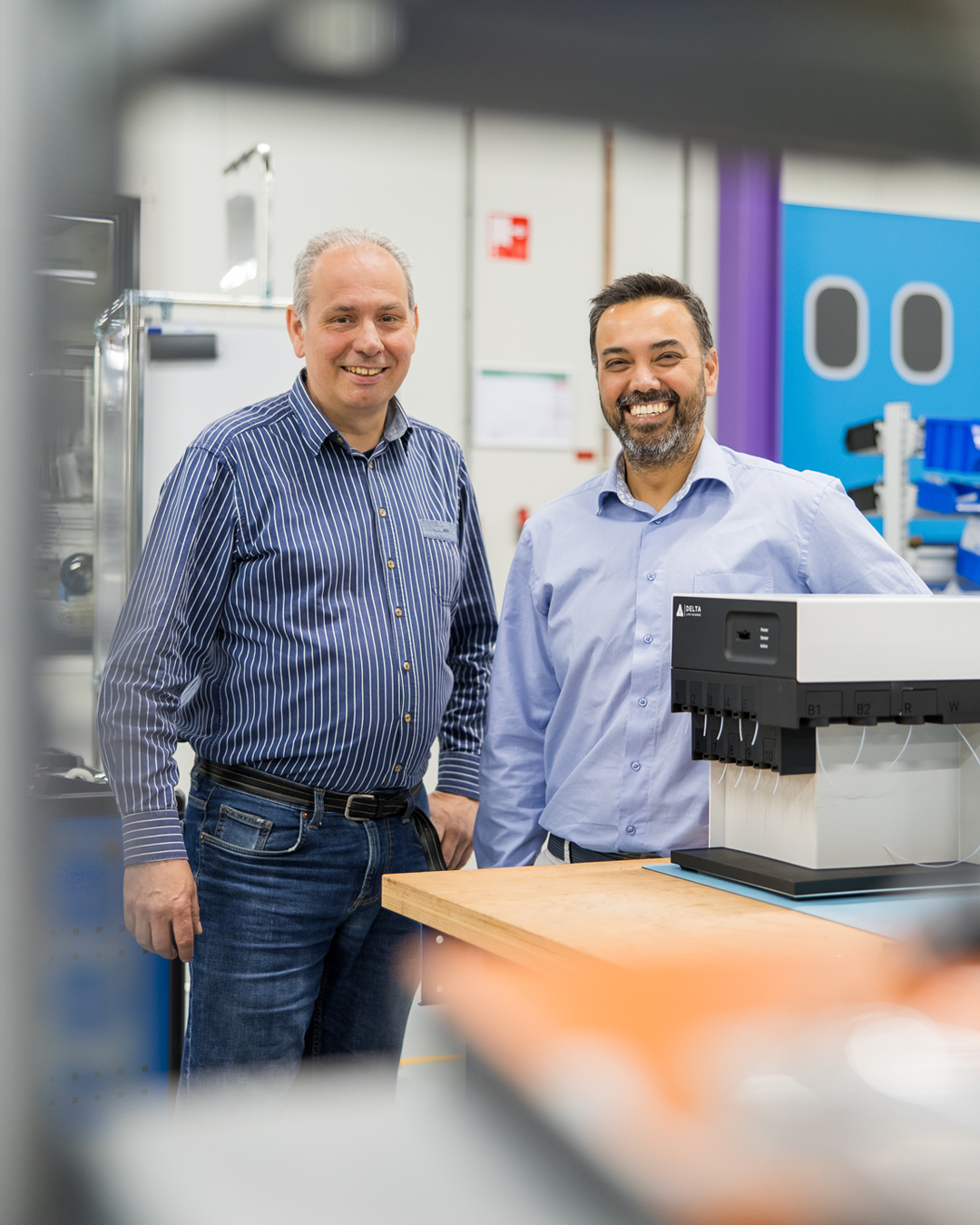The inQuiQ® was launched in June 2024 by Delta Life Science. This compact device can measure the binding of molecules – with exceptional precision, in real time, and simultaneously for different molecules in multiple samples. This can significantly accelerate pharmaceutical research, and at lower cost. Sioux Technologies developed the entire system in just nine months and has already built ten units.
By Bert de Swart, System Architect at Sioux & Siddharth Seth, Senior Project Manager at Sioux (from left to right on photo)
Delta Life Science, based in Rotterdam, was founded in March 2018 as a spin-off from TNO, emerging from around ten years of research into biosensor technology at the optics department of this knowledge institute. The company’s first product, the inQuiQ, is now available, featuring Delta’s core Nanophotonic Evanescent field Sensing (NES) technology.
Local refractive index
In the inQuiQ, light is guided through nanoscale loop-shaped waveguides. These are integrated into a photonic chip onto which antibodies can be applied. When the biomolecules being tested – for example proteins, DNA, small molecules, or peptides – bind to these, the local refractive index changes. This affects the resonant frequency of the light resonators. By measuring this change with extreme precision, it is possible to determine, among other things, the degree of chemical bonding.
Regenerable sensor chips
Delta Life Science’s technology is groundbreaking. The inQuiQ can analyse up to ten samples in a single run, with flows through four channels. Each channel contains four independent sensors. This means that up to 16 measurements per chip are possible. Other unique features include regenerable sensor chips and the fact that measurements require samples of only 10 to 25 microlitres. Moreover, the device is highly compact, affordable, and widely applicable: for fundamental research, kinetic drug screening, antibody characterisation, food safety testing, and more.
Fourfold acceleration
Delta Life Science began developing its technological concept further in 2022. The inQuiQ had to accelerate research by at least a factor of four compared with existing technologies, while the total cost of ownership (purchase and lifetime use) had to be five times lower. The following year, the company brought in Sioux to take the concept from paper to a working device – highly sensitive and cost-effective.
Making an impact
As always, this partnership began with presenting a list of requirements. At Sioux, we first assess whether we want to take on the project and what value we can add. This usually requires several discussions, in which we gain a solid understanding of the technology and the challenge at hand in order to determine how best to help. A project must also fit with our mission: Sioux aims to make an impact, including socially. To win the assignment, we naturally had to make a strong proposal. In this case, all the pieces fell into place.
Time and money
Sioux works as a development and production partner for renowned large companies but also supports businesses that are yet to enter the market. In the latter case, lack of time and money is usually a challenge. Sioux can make the difference here, as it has proved many times – and again in the project for Delta Life Science. We carried out detailed concept studies, reduced the risks of key functionalities through Functional Mock-ups (FUMOs), and developed the inQuiQ in nine months. That was no small feat.
From ‘fridge-sized’ to desktop
Delta Life Science’s technology is complex; if it were easy, the company would not have approached Sioux. There were plenty of challenges. The device had to look good, but the main challenge was its intended size. Current instruments that measure molecular binding, such as Surface Plasmon Resonance (SPR) systems, are roughly the size of a fridge. The inQuiQ, by contrast, takes up no more space than an A3 sheet and is only 35 centimetres tall, making it desktop-friendly. Nevertheless, it contains numerous components, such as cameras, lenses for focusing laser light, and moving parts.
Fluid flows
The inQuiQ is packed with technology, which is a design challenge in itself, particularly considering the need for high-quality sensors, optics, moving components, and thermal management. The system must also operate with micrometre-level mechanical precision. The photonic chip needs to be kept at a controlled temperature to optimally observe the chemical process. The fluid flows carrying the samples to be analysed – in microlitre quantities – must maintain a constant speed, which places high demands on the fluid pumps.
1,000 measurements per second
In addition to the hardware, Sioux also developed the Linux-based software platform that drives the inQuiQ. This operates at remarkable speed: the system performs more than 1,000 measurements per second and processes them into a new data point every second. The electronics are designed accordingly. In short, all the technology works together seamlessly thanks to our integrated approach, which also ensured the necessary speed in development, testing, validation, and prototyping, including supply chain organisation.
